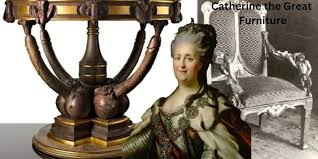Catherine the Great Furniture: A Look into Opulence and Design

Historical Context of Catherine the Great’s Reign
catherine the great furniture reign, spanning from 1762 to 1796, marked a pivotal period in Russian history characterized by significant political, social, and cultural transformations. Ascending to the throne after a coup that ousted her husband, Peter III, Catherine sought to solidify her power and position Russia as a formidable European nation. Her reign is often associated with the larger Age of Enlightenment, during which European ideas about governance, philosophy, and culture began to infiltrate Russian society.
Catherine’s ambition to modernize and westernize Russia played a crucial role in shaping various aspects of its culture, including architecture and design. She was influenced by the reformist spirit of the Enlightenment and sought to bring Russia in line with contemporary European standards. This initiative extended to the realm of art and furniture design, where she fostered a climate of creativity and craftsmanship. The opulent furniture that came to define this era not only served practical purposes but also acted as symbols of power and prestige. Artisans and craftsmen were commissioned to create intricately designed pieces that reflected European styles, often blending them with traditional Russian elements.
Design Characteristics of Catherine the Great Furniture
catherine the great furniture reign from 1762 to 1796 marked a significant transformation in Russian interior design, with her furniture collection often reflecting the opulence and artistic sensibilities of the time. The furniture from this era is characterized by its elaborate craftsmanship, showcasing the mastery of skilled artisans. One of the most notable design characteristics is the extensive use of gilded wood, which was employed not only for aesthetics but also to symbolize wealth and power. The gleaming surfaces were often enhanced with intricate carvings, depicting motifs such as leaves, flowers, and even mythological figures, thereby adding a theatrical flair to the overall design.
In terms of fabrics, luxurious materials such as silk and velvet were favored by catherine the great furniture adding a sumptuous touch to furniture pieces. The sumptuous upholstery often featured vibrant colors and elaborate patterns, which were designed to complement the gilded frameworks. These choices not only contributed to the visual appeal but also reflected the cultural exchanges taking place in Europe during Catherine’s rule, as Russian furniture began to adopt Western influences.
Two prominent styles emerged during this period: Rococo and Neoclassicism. Rococo pieces are noted for their asymmetrical designs and ornate embellishments, illustrating the exuberance of the French style. In contrast, Neoclassicism, which gained traction later in her reign, emphasized simplicity and grandeur, drawing inspiration from ancient Roman and Greek art. Noteworthy pieces from this collection range from grandiose tables and chairs to exquisite cabinets, each blending artistic creativity with functionality. The interplay between aesthetics and utility is a defining feature of Catherine the Great furniture, highlighting her sophisticated taste and commitment to elevating Russian artistry in furniture design.

catherine the great furniture Contributions to Interior Design
Catherine the Great, the influential Empress of Russia, made substantial contributions to the sphere of interior design, significantly shaping the aesthetic environment of her palaces. Her visionary approach transformed royal residences into masterpieces adorned with exquisite furniture, vibrant colors, and luxurious materials that epitomized opulence. Among her notable residences, the Winter Palace and Tsarskoye Selo stand out as prime examples of her refined taste and discerning eye for detail.
At the Winter Palace, located in St. Petersburg, Catherine curated rooms that displayed not only her personal aesthetic but also her status as one of the most powerful women of the era. The selection of furniture was particularly remarkable, with pieces often commissioned from renowned craftsmen and artisans. These bespoke creations included gilded chairs, intricately carved tables, and magnificent cabinets that became emblematic of the lavish lifestyle in the Russian court. The careful arrangement of these furnishings further enhanced the grandeur of the palace’s interiors, where each room told a story of elegance and refinement.
Moreover, Catherine’s contributions extended to Tsarskoye Selo, her summer residence, where she influenced the design of grand salons and opulent galleries. She collaborated closely with prominent designers, such as Bartolomeo Rastrelli, to ensure that the furnishings complemented the overall architectural vision. The incorporation of ornate mirrors, plush upholstery, and unique lighting elements not only elevated the aesthetics of these spaces but also reflected Catherine’s appreciation for art and culture. Her remarkable ability to harmonize her furniture choices with the architecture of her palaces underscored her legacy in Russian interior design.
Through her innovative selections and collaborations, catherine the great furniture effectively established a template for opulent living, influencing subsequent generations of designers and reshaping the landscape of Russian interiors. Her passion for elegance and a profound understanding of interior decoration continues to resonate, making her one of the most significant figures in the history of furniture design in Russia.
Legacy of Catherine the Great Furniture Today
The legacy of catherine the great furniture continues to exert a significant influence on contemporary design, reflecting an enduring fascination with the opulence and artistry characteristic of her regal period. Today, interior designers and collectors alike draw inspiration from the sumptuous aesthetics of the 18th century, particularly the ornate styles that defined the furniture of Catherine’s reign. Her furniture is not merely a subject of historical interest; it serves as a rich source of inspiration for modern craftsmanship and design innovations.
In recent years, there has been a marked resurgence in interest regarding historical furniture styles, and the works associated with catherine the great furniture have seen a remarkable revival. Museums and restoration projects dedicate significant resources to preserving and highlighting her furniture’s grandeur, showcasing its unique craftsmanship and luxurious materials. Through exhibitions and curated displays, the elegance of Catherine the Great’s furniture is presented to new audiences, ensuring that her legacy remains palpable in the contemporary cultural landscape.
Furthermore, the design community actively incorporates elements inspired by the distinctive styles of catherine the great furniture era. Contemporary furniture makers often utilize luxurious materials such as mahogany and gilded accents, mirroring the richness found in historic pieces. These modern interpretations celebrate the artistry of the past while providing functional and stylish options for today’s interiors. Collectors and enthusiasts actively seek out restoration projects that reflect Catherine’s aesthetic, thus fostering admiration for the intricate detailing and exquisite designs she championed.
The continuation of this legacy not only ensures that Catherine the Great’s influence is felt in modern design but also emphasizes the importance of historical resonance in furniture today. As designers and collectors explore her opulent styles, the connection between past and present is cemented, allowing the spirit of catherine the great furniture to endure in modern elegance.



